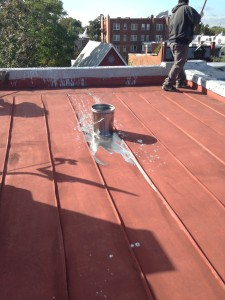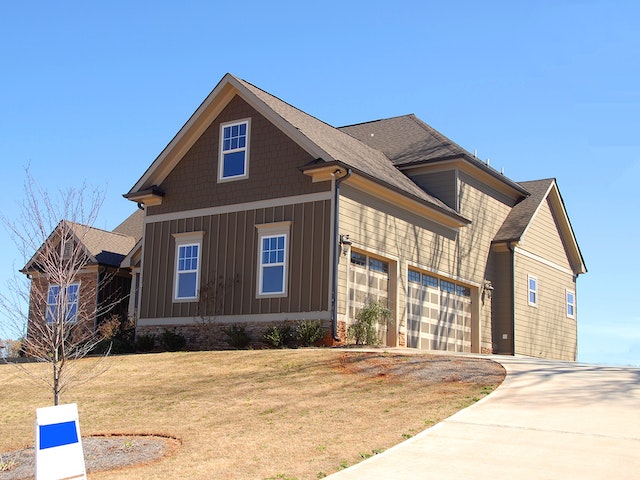 Whether your flat roof is fifty years old or five years old, material selection, weather, grade and installation are major factors on how it will hold up. Modified and standing seam are slowly giving way to both EPDM and TPO. EPDM relies heavily on installation expertise, as it utilizes primers, and tapes that are highly influenced by temperature at installation. TPO is a welded system and less reliant on the many pieces required by EPDM. These are both fantastic products and both have unique advantages with flat roofs.
Whether your flat roof is fifty years old or five years old, material selection, weather, grade and installation are major factors on how it will hold up. Modified and standing seam are slowly giving way to both EPDM and TPO. EPDM relies heavily on installation expertise, as it utilizes primers, and tapes that are highly influenced by temperature at installation. TPO is a welded system and less reliant on the many pieces required by EPDM. These are both fantastic products and both have unique advantages with flat roofs.
Flat roofs are popular for residential and commercial building owners since they offer attractive advantages. A flat roof, also known as a low-slope roof, is any roof with a slope of less than 4-5 times the width of the roof. Unlike traditional pitched roof systems, a flat roof is more economical in terms of materials and labor costs, permitting easy access to the roof and the ability to install outdoor air conditioning units, solar systems, etc. Let us inform you of everything you need about Flat Roofs.
Overview and Benefits of Flat Roofs
A Flat Roof is relatively simple to install and considerably cheaper than a traditional pitched roof. Flat roofs provide an utterly horizontal plane across the top of the building, permitting cost-effective and practical insulation. With a low-slope roof, exterior areas become an easily accessible outdoor living space that adds charm to your home and provides storage areas or green surfaces that collect rainwater. Furthermore, given that the material is usually metal, flat roofs are highly weather resistant, adding to their lifespan.
Types of Flat Roofs
When it comes to flat roofs, there are two main types – membrane-based and built-up roofs. Membrane-based roofs are the most common and are much cheaper in comparison. They are made with sheets of synthetic rubber installed in multiple layers to ensure protection and are perfect for moderate climates. The second type involves several self-adhesive layers of flat membranes (usually asphaltic sheets). It overlaps them with one another to render them waterproof and hence, is best suited for icy places.
Flat Roof Materials
The number of options for flat roof materials is plentiful for residential and commercial building owners. The finest material for you will rely on your individual needs, even though each material has advantages. Common materials used on flat roofs include modified bitumen, elastomeric coatings, liquid-applied membranes, EPDM, and PVC, which is the most popular.
Flat Roof Installation
The installation process and techniques used for Flat Roofs will depend on the materials you choose and your goals for the roof. Generally, installation labor will include some or all of the following:
- Remove old roofing
- Install insulation
- Install base sheet
- Apply layers of membrane
- Install flashing
- Secure the membrane to the roof
- Install a protective layer to prevent UV rays
- Inspect the roof and correct any issues
Flat Roof Maintenance
Roofs that must be adequately maintained can experience many problems, including water leakage, leading to potentially costly repairs. To prevent this, it is essential to make sure that you have a maintenance plan for your flat roof. This maintenance should include cleaning, inspection, and repairs.
- Cleaning – Inspecting the flat roof regularly, removing any gathered debris, and removing moss or foliage growing in the substrate material is essential. Any loose surfaces should also be re-secured.
- Inspection – Regular inspection of your flat roof will enable you to identify potential problems before they become significant. If there are any leaks or failures in the roof’s surface, they should be noted and dealt with promptly.
- Repairs – Any repairs that need to be made should be handled quickly to prevent more severe damage from occurring. Hiring a professional roof maintenance company to handle any major repairs or replacements is best.
Flat Roof Drainage Solutions
Flat roofs need proper drainage as the nearly flat surface can trap water and lead to severe problems like leaking and structural damage. A good drainage plan must be in place to prevent such issues. Gutters, downspouts, and flashing are standard drainage systems for flat roofs. Additionally, drainage ditches, projects, and risers can be installed to ensure water can quickly move away from the roof surface.
Flat Roof Life Expectancy
The life expectancy of a Flat Roof depends mainly on how well it is maintained and the materials used in its construction. Generally, a flat roof will last about 15-25 years, depending on the materials used and location. If the roof is installed correctly and maintained regularly, it can last up to 40 years.
FAQs About Flat Roofs
Q: How long will a flat roof last?
A: Generally, a flat roof can last 15-25 years, depending on the materials used and where it is located, and can potentially last up to 40 years with proper installation and maintenance.
Q: Does a flat roof need to be sealed?
A: Flat roofs require regular sealing to prevent moisture from seeping into the roof and causing damage.
Q: What is the best way to maintain a flat roof?
A: The best way to maintain a flat roof is to inspect the roof regularly and clear any accumulated debris. Additionally, any moss or foliage growing in the substrate must be removed, and any loose surfaces should be re-secured.
Q: What type of material is best for flat roofs?
A: PVC is the most popular material for flat roofs and is best for moderate climates. Other materials, such as modified bitumen, elastomeric coatings, and liquid-applied membranes, are also used depending on the climate and specific project needs.
Q: Is a flat roof more expensive than a pitched one?
A: Generally, flat roofs are less expensive than traditional pitched roofs regarding materials and labour costs.
Conclusion
Flat roofs have many advantages over sloped roofs, such as easier access, passive solar cooling, fewer maintenance requirements, and improved drainage. However, they are also more vulnerable to water damage if proper maintenance and repairs are not performed promptly. In conclusion, when considering a roof for a structure, it is important to weigh the advantages and disadvantages of both flat and sloped roofs to make the best decision for the situation.









